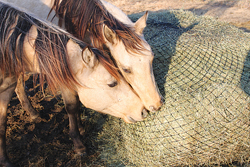 Erin Olson was tired of playing hay police to her fast eating Alpha mare so that her other horses could get their fair share of hay. She and her friend and partner in a barefoot trimming business, Kris Anderson, began searching for ways to spend less time doing chores.
Erin Olson was tired of playing hay police to her fast eating Alpha mare so that her other horses could get their fair share of hay. She and her friend and partner in a barefoot trimming business, Kris Anderson, began searching for ways to spend less time doing chores.
The small hay nets they found seemed to work. Having to pull hay through holes slows down the horses that eat more than their share, and all the horses thrive on the slow feed system.
“We thought it would be nice if there was a net for big round bales,” Olson says, since big bales reduce labor and are less expensive than buying hay in small bales. After not finding any nets on the market they made a couple. “It worked so well. There was no waste – with a round bale that’s hard to believe,” Olson says.
A University of Minnesota feeder trial study confirmed that typically up to 57 percent of a round bale goes to waste when fed to horses. There was only 6.3 percent waste with Olson and Anderson’s net.
In 2009, the women started marketing their patent-pending CinchChix hay nets.
“We use U.S. knotted netting – Dupont nylon. It’s nontoxic UV-treated so it’s stable in sunlight,” Olson says. The marine-grade netting is hand sewn into bags in Duluth. The partners add the cinch strap – polypropylene rope and a “keeper” closure also from the marine industry.
CinchChix offers nets in several sizes – from mini bags that hold half a small square bale to large for large round and square bales. Nets come with extra nylon string to mend tears.
CinchChix also offers nets with various hole sizes. The 1 3/4-in. dia. holes work for most animals, Olson says. But, 1 1/4-in. and 1-in. dia. hole nets can be a better option for horses that are really big eaters and tend to founder.
It takes some time for the horses to get used to the hay net. CinchChix suggests having loose hay next to the net until the animals adjust.
“The hole size works for many animals, including sheep, goats, donkeys, llamas and alpacas,” Olson says. “We were at the State Fair and beef producers were interested in it. They want to do a study with cattle.”
1-800-834-9665
Bale Feed Nets Reduce Wasted Hay
FARM SHOW Magazine » Bale Feed Nets Reduce Wasted Hay
Bale Feed Nets Reduce Wasted Hay
